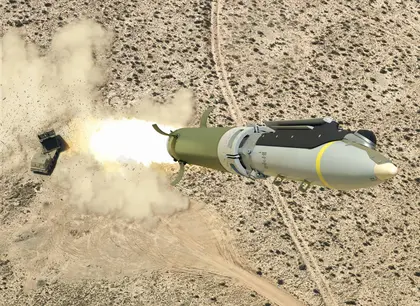Delivery of long-range missiles to Ukraine originally slated for spring of this year has been pushed back to 2024, according to reports, a setback to Kyiv’s ability to strike targets deep inside Russian-occupied territory.
The US was first approached by Boeing to buy and ship Ground Launched Small Diameter Bombs (GLSDB) to Kyiv last fall with the most optimistic timeline for shipping seeing them arrive just a few months later.
JOIN US ON TELEGRAM
Follow our coverage of the war on the @Kyivpost_official.
According to Reuters, sources familiar with the issue now say delivery to the US from Boeing will take place this month but several months of testing are required before they can be shipped on to Ukraine.
Why is the GLSDB different from other precision-guided missiles the Americans have sent Ukraine?
The GLSDB missile is a clever, post-Cold War Pentagon weapons idea that actually bore fruit.
The US Army in the 2000s found itself with big reserves of 227mm unguided rockets designed to be fired in massed salvoes from its M270 and HIMARS rocket artillery systems, and a need to hit smaller targets in wars in Afghanistan and Iraq, while minimizing collateral damage.
The solution was to mate old 227mm rocket motors with a GBU-39 precision-guided glider bomb manufactured by Boeing for some time and figure out how to shoot that from an M270 or a HIMARS.
By 2015 Seattle-headquartered Boeing was working with Sweden’s Saab Group to test the rocket-launched glider bomb, and by 2019 the Swedes had a reliably working system, according to news reports at the time.

Ukraine’s Elite Special Ops: Top Missions of 2024 – From Black Sea to Kursk
The rocket went up and the glider bomb detached and flew into its target. Now Saab touts it as a functioning system, in production, and able to perform as advertised.
The shorter-ranged M31 missile, which fires from the same platforms and whose delivery to Ukraine’s Armed Forces (AFU) in early summer 2022 devastated Russia’s ability to operate headquarters and ammunition depots near the front, is also uses GPS for its guidance system, but nothing detaches from it.
The missile just flies from the launcher to the target in a ballistic arc, then blows up. It carries a powerful 91-kilogram warhead.
US Marine officers stand next to a M142 versioj of HIMARS during exercises between the Philippine Marine Corps and US Marine Corps last year. PHOTO: AFP
How effective is the GLSDB missile? What’s new about it?
According to open source reports the key advantage of the GLSDB missile, besides having roughly twice the range (150 kilometers vs. 80 kilometers), is low cost, reportedly $40,000, as compared to the $500,000 price tag for a single M31 missile.
Perhaps even more important for the intense artillery fighting in the Russo-Ukraine war, the US military’s conventional forces are no longer even fighting an insurgency, and it is likely that the US has tens of thousands of unguided 227mm rockets in its arsenals that could be sent to Saab for repurposing into glider bomb carriers.
Saab is an experienced and tested arms manufacturer with a history of building weapons that are easy to use and work in harsh environments. Although the GLSDB is not known to have ever been used in combat, odds are, it will perform in Ukraine as designed.
According to Saab, the glider can be programmed to approach a target from any direction, and from a variety of angles, making it more difficult to intercept, and giving the bomb better approach vectors for strikes on targets hiding on the far side of a hill or in a narrow valley.
So, is the GLSDB is a game-changer?
That’s unlikely. One problem is numbers.
Although in theory there are few limits to how many 227mm rocket motors the Americans could bring to the table, the big open question is the size of Saab’s glider bomb inventory, as well as the company’s physical capacity to manufacture more.
In a mid-January interview with Kyiv Post, an M270 crew said that given sufficient ammo and targets they could launch a dozen missiles every 24 hours without particularly breaking a sweat.
According to Oryx, an arms data collator, the AFU probably operates around 15 M270 and 30 HIMARS systems, meaning the AFU might well be able to fire off Saab’s annual production capacity of GLSDB missiles in a few days or weeks.
A second – less critical but still important – drawback of the GLSDB missile is that although it is the same caliber as the shorter-ranged M31, it carries a smaller warhead, with about one-third less explosives, depending on the type.
For setting off an explosion in a Russian ammo depot, the GLSDB still delivers more than enough blast, but for knocking down a reinforced-concrete bridge or spreading anti-personnel cluster munitions over a big area, the shorter-range M31 is probably at least twice as effective.
A final theoretical weakness is the fact that the GLSDB flies to its target as a glider, not a ballistic missile, making it easier, at least on paper, for Russian air defense units to shoot it down.
This is, however, a question no one can answer, because the weapon has not been tested in combat.
A US M142 version of HIMARS fires salvoes during exercises in Morocco last year. PHOTO: AFP
Then what can we expect? And when?
Were two to three hundred missiles to reach the AFU inventory in the short term, that would probably be sufficient to devastate the rear area of a major Russian defensive formation prior to a large-scale Ukrainian offensive, whose success, though not guaranteed, would certainly be helped.
If the Russian military is efficient, it will move its headquarters, communications centers and ammunition depots farther away from the front line of fighting, to prevent their destruction once significant numbers of the missiles are fielded.
If the past is any indication, the Russian army should manage to do that in time. The Kremlin has repeatedly called delivery of “long-range” precision-strike weapons to Ukraine a red line that destabilizes security in Europe and increases chances of nuclear confrontation.
Beyond words, however, Moscow has not responded to new deliveries of long-range weapons in the past, such as the M31 missile. Longer-term, Saab is an efficient corporation, the Americans reportedly have thousands of 227mm rocket motors suitable to GLSDB conversion, and the Ukrainian Defense Ministry, notwithstanding the tens of billions of dollars’ worth of foreign arms already received, has consistently focused on cheaper weapons allowing precision strikes as its top priority.
At minimum, as long as the foreign funding holds out and provided the GLSDB works as planned, it is highly likely that Saab has acquired a major, long-term customer and a source of orders lasting long beyond the end of the war.
You can also highlight the text and press Ctrl + Enter








